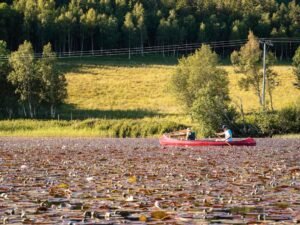

Speak Like a Native: 20 Norwegian Verbs to Sound Fluent
Verbs are an essential part of any language, and Norwegian is no exception. In order to speak Norwegian fluently, it is important to have a good understanding of verb conjugation and usage. Norwegian verbs can be quite complex, but with some practice and dedication, you can become proficient in using them correctly.
The structure of Norwegian verbs is similar to that of other Germanic languages. They are conjugated based on tense, person, and number. In Norwegian, there are three main tenses: present, past, and future. Each tense has its own set of conjugation rules that must be followed.
Table of Contents
ToggleKey Takeaways
- Norwegian verbs are essential for fluent speaking in the language.
- Understanding verb conjugation is crucial for using Norwegian verbs correctly.
- Common Norwegian verbs like “å være” and “å ha” are useful for everyday conversation.
- Advanced Norwegian verbs like “å forstå” and “å oppleve” can help create more complex sentences.
- Reflexive verbs like “å vaske seg” and “å kle på seg” are important in Norwegian.
Understanding verb conjugation in Norwegian
a) Present tense conjugation rules:
In the present tense, Norwegian verbs are conjugated based on the subject pronoun. For regular verbs, the endings are added to the stem of the verb. For example, the verb “å snakke” (to speak) becomes “jeg snakker” (I speak), “du snakker” (you speak), “han/hun snakker” (he/she speaks), etc.
b) Past tense conjugation rules:
In the past tense, Norwegian verbs are conjugated by adding the suffix “-te” or “-de” to the stem of the verb. For example, the verb “å spise” (to eat) becomes “jeg spiste” (I ate), “du spiste” (you ate), “han/hun spiste” (he/she ate), etc.
c) Future tense conjugation rules:
In the future tense, Norwegian verbs are conjugated by adding the auxiliary verb “skal” before the infinitive form of the verb. For example, the verb “å gå” (to go) becomes “jeg skal gå” (I will go), “du skal gå” (you will go), “han/hun skal gå” (he/she will go), etc.
Common Norwegian verbs for everyday conversation
a) Verbs for greetings and introductions:
Some common verbs for greetings and introductions in Norwegian include “å hilse” (to greet), “å presentere” (to introduce), and “å snakke” (to speak). These verbs are essential for starting conversations and making a good first impression.
b) Verbs for ordering food and drinks:
When dining out or ordering food and drinks in Norway, it is important to know the appropriate verbs. Some common verbs for ordering food and drinks include “å bestille” (to order), “å spise” (to eat), and “å drikke” (to drink).
c) Verbs for asking for directions:
If you find yourself in need of directions in Norway, it is helpful to know the right verbs to use. Some common verbs for asking for directions include “å spørre” (to ask), “å finne” (to find), and “å gå” (to go).
Advanced Norwegian verbs for more complex sentences
a) Verbs for expressing emotions and feelings:
In order to express emotions and feelings in Norwegian, it is important to have a good vocabulary of descriptive verbs. Some common verbs for expressing emotions and feelings include “å være glad” (to be happy), “å være trist” (to be sad), and “å være sint” (to be angry).
b) Verbs for describing actions and events:
When describing actions and events in Norwegian, it is important to use the appropriate verbs. Some common verbs for describing actions and events include “å løpe” (to run), “å danse” (to dance), and “å lese” (to read).
c) Verbs for discussing opinions and beliefs:
When discussing opinions and beliefs in Norwegian, it is important to use verbs that convey your thoughts accurately. Some common verbs for discussing opinions and beliefs include “å mene” (to think), “å tro” (to believe), and “å synes” (to think).
Using reflexive verbs in Norwegian
a) Definition and examples of reflexive verbs:
Reflexive verbs are verbs that indicate that the subject is performing an action on itself. In Norwegian, reflexive verbs are formed by adding the reflexive pronoun “seg” to the end of the verb. For example, the verb “å vaske” (to wash) becomes “å vaske seg” (to wash oneself).
b) How to conjugate reflexive verbs in Norwegian:
Conjugating reflexive verbs in Norwegian follows the same rules as regular verbs, with the addition of the reflexive pronoun “seg”. For example, in the present tense, the verb “å vaske seg” is conjugated as follows: “jeg vasker meg” (I wash myself), “du vasker deg” (you wash yourself), “han/hun vasker seg” (he/she washes himself/herself), etc.
c) Common reflexive verbs in everyday conversation:
Some common reflexive verbs that are used in everyday conversation include “å kle på seg” (to get dressed), “å vaske seg” (to wash oneself), and “å barbere seg” (to shave oneself). These verbs are used to describe actions that a person does to themselves.
Irregular Norwegian verbs to watch out for

a) Explanation of irregular verb conjugation in Norwegian:
While most Norwegian verbs follow regular conjugation patterns, there are some that are irregular and do not follow the standard rules. These irregular verbs have unique conjugation patterns that must be memorized.
b) Examples of common irregular verbs:
Some common irregular verbs in Norwegian include “å være” (to be), “å ha” (to have), and “å gjøre” (to do). These verbs have irregular conjugation patterns in all tenses and must be learned individually.
c) Tips for memorizing irregular verb conjugation:
To memorize irregular verb conjugation in Norwegian, it is helpful to create flashcards or practice exercises. Repetition and consistent practice are key to mastering the conjugation of irregular verbs.
Tips for practicing Norwegian verb usage
a) Importance of consistent practice:
In order to become proficient in using Norwegian verbs, it is important to practice regularly. Consistent practice will help you internalize the conjugation patterns and usage of verbs.
b) Incorporating verbs into daily routines:
One way to practice Norwegian verb usage is to incorporate verbs into your daily routines. For example, when cooking or cleaning, try to think of the appropriate verbs in Norwegian and use them in sentences.
c) Utilizing language exchange programs and resources:
Language exchange programs and resources can be a valuable tool for practicing Norwegian verb usage. These programs allow you to interact with native speakers and receive feedback on your language skills.
Incorporating phrasal verbs in Norwegian speech
a) Definition and examples of phrasal verbs:
Phrasal verbs are combinations of a verb and one or more particles (prepositions or adverbs) that together have a different meaning than the individual words. For example, the phrasal verb “å stå opp” (to get up) consists of the verb “å stå” (to stand) and the particle “opp” (up).
b) How to use phrasal verbs in Norwegian sentences:
Phrasal verbs are used in Norwegian sentences just like regular verbs. The particle is placed after the verb, and the conjugation follows the regular rules. For example, “jeg står opp” (I get up), “du står opp” (you get up), “han/hun står opp” (he/she gets up), etc.
c) Common phrasal verbs in everyday conversation:
Some common phrasal verbs that are used in everyday conversation include “å gå ut” (to go out), “å komme tilbake” (to come back), and “å sette seg ned” (to sit down). These phrasal verbs add depth and nuance to your speech.
Common mistakes to avoid when using Norwegian verbs
a) Misconceptions about verb conjugation:
One common mistake when using Norwegian verbs is assuming that they follow the same conjugation patterns as English or other languages. It is important to learn the specific conjugation rules for Norwegian verbs.
b) Overuse of certain verbs:
Another common mistake is overusing certain verbs and not expanding your vocabulary. While it is natural to rely on familiar verbs, it is important to learn new ones to express yourself more accurately.
c) Incorrect word order in sentences:
Word order is crucial in Norwegian, and using the wrong word order can change the meaning of a sentence. It is important to pay attention to the correct placement of verbs in sentences.
Resources for further improving Norwegian verb usage
a) Online courses and tutorials:
There are many online courses and tutorials available that can help you improve your Norwegian verb usage. Websites like Duolingo, Babbel, and Memrise offer interactive lessons and exercises.
b) Language exchange programs and apps:
Language exchange programs and apps, such as Tandem and HelloTalk, allow you to connect with native Norwegian speakers who are learning your native language. This provides an opportunity to practice verb usage in a conversational setting.
c) Norwegian language textbooks and workbooks:
Traditional language textbooks and workbooks can also be a valuable resource for improving your Norwegian verb usage. These resources often provide comprehensive explanations and exercises to practice verb conjugation and usage.
In conclusion, mastering Norwegian verbs is essential for fluent speaking. Understanding verb conjugation rules, learning common verbs for everyday conversation, and practicing consistently are key to improving your verb usage. By incorporating reflexive verbs, phrasal verbs, and avoiding common mistakes, you can become proficient in using Norwegian verbs. Utilizing resources such as online courses, language exchange programs, and textbooks will further enhance your verb skills. With dedication and practice, you can confidently use Norwegian verbs in any conversation.
If you’re looking to expand your understanding of Norwegian verbs, you might also be interested in this related article on the nuances of verbs of understanding in Norwegian. Understanding the difference between “å forstå” and “å skjønne” can greatly enhance your fluency in the language. Check out the article here to learn more about these important verbs and how to use them correctly.
If you want to learn Norwegian, you can register for classes here. We look forward to hearing from you and helping you become fluent in Norwegian.





